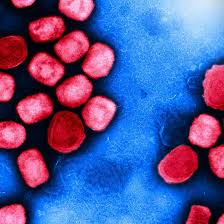As the world was grappling with the after-effects of a pandemic, in walks another health hazard: monkeypox. Traditionally found in central and west Africa, under the canopy of tropical forests, it has now made its way to urban areas. Both the WHO and the UK Health Security Agency are working to reduce the spread of this global calamity.

Monkeypox
This is a disease characterized by virus transmission from animals to humans (viral zoonosis) with symptoms like smallpox. The double-stranded DNA of the Monkeypox virus that belongs to the genus Orthopoxvirus presents two different genetic compositions demarcating the origin of the disease.

This distinction between two kinds of Monkeypox signifies the west and central Africa and the very rare chance of both types being found in the same country has been reported from Cameroon.
What we know so far: history and symptoms
The first case of Monkeypox was reported in 1970, from the Republic of Congo in a 9-year-old boy with symptoms of smallpox. But as smallpox has already been eliminated from the region it gave space for a new study.
Initially, it occurred in countries of the African continent like the Democratic Republic of Congo, Benin, Cameroon, the Central African Republic, Gabon, etc. But later on, the first case was reported from the United States of America in 2003. The reason for this infectious disease was claimed to be the pet prairie which was housed with Gambian pouched rats imported from Ghana.

From then on the endemic virus started spreading to and from countries like the US, UK, Nigeria, Israel, and Singapore. In 2022 it was found in India and other non-endemic countries.
The WHO has pointed out that the infection spreads from animals’ cutaneous or mucosal lesions and bodily fluid contacts. Rodents have been identified as the main source of this disease.

Signs and symptoms to recognize Monkeypox are claimed to be of 6 to 13 or 5 to 21 days of incubation period as symptoms take time to show. Some of them include:
- The invasive period where the virus enters the body lasts from 0-5 days and is marked by intense fever, headaches, back pains, muscle pains and swelling in lymph nodes.
- The skin lesions start approximately 3 days after the onset of fever and mostly occur on the face (95%) followed by hands and feet (75%). The percentages reduce with oral membranes (70%), genitalia (30%) and conjunctivae (20%).
Discoveries leading to new understandings
The conventional study of Monkeypox has produced isolation and medical intervention helping the patient till the final step of treatment. The disease usually subsides after 2 to 4 weeks of persistent health issues but also varies based on the patient’s health conditions, natural environment, and virus exposure.
But the recent study conducted and yet to be confirmed by the UK Health Security Agency claims that only isolation of the patient might not help them.

The varying results of this study point out that men involved in same-sex sexual activities prone to Monkeypox than compared otherwise. Moreover, the incubation period differs from what was found during the previous study.
The onset of fever as the first symptom is after almost 8 days of infection which is enough for the virus to be communicated to others around the patient. The case differs as the patient in question might have been exposed to another patient who still has to show symptoms of the virus.
Need for more study
With the latest research and consistent and continuous development of this disease, more studies are required to map and understand the virus.
It is essential to build up a case scenario to encounter the need for vaccination and provide ultimate assistance to the patients. Monkeypox is a deadly virus which affects everyone differently but that does not become a means of hindrance in the path of assistance and cure.

To produce a vaccine as was done in the case of smallpox a new and detailed study on patients and the causes behind them is required. While the WHO has declared Monkeypox a global health emergency at the initial stage we still need more time to come up with exact medication and prevention.
As symptoms take time to announce their presence the rate of fatality might increase in future. The changing lifestyle and the climate or environment of the patients’ surroundings do add to the reasons for the virus taking over.
India at a glance
With the growing scare of Monkeypox, India has also reported multiple cases from across the country.

The social taboo of excluding an individual with a visible skin lesion and who is suffering from a disease that has the chance of fatality stands as a barrier between the need for assistance and the providence of it.
We, as a sufficiently efficient society, should come forth and tackle the taboo concerning communicable diseases and not outcast the patient.
Read More: “Covid is still an international emergency” says WHO













